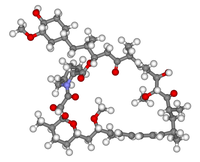
Photo from wikipedia
R (sirolimus) was isolated in 1975 from actinomycete Streptomyces hygroscopicus in a soil sample collected during a Canadian expedition to Easter Island (Rapa Nui). The target of rapamycin (TOR) was… Click to show full abstract
R (sirolimus) was isolated in 1975 from actinomycete Streptomyces hygroscopicus in a soil sample collected during a Canadian expedition to Easter Island (Rapa Nui). The target of rapamycin (TOR) was discovered in 1994 in the yeast Saccharomyces, is a ubiquitous and highly conserved enzyme complex in a pathway with a key role in physiological homeostasis. Deregulation of its activity is associated with a variety of diseases. The first phase I study of ascending doses of sirolimus in stable kidney transplant recipients receiving cyclosporine and prednisone was published in 1996. Subsequent phase II and III clinical trials led to regulatory approval by the Food and Drug Administration in 1999 for the prophylaxis of rejection after kidney transplantation in combination with cyclosporine and steroids. Everolimus followed the same path and was subsequently approved for kidney, heart, and liver transplantation. Sirolimus and everolimus analogs were approved for prevention of intrastent restenosis (pharmacological stents) and for the treatment of some cancers, highlighting the central role of the pathway in disparate disease states. This supplement summarizes recent data and provides critical analysis of the accumulated knowledge of the biological effects of mTOR inhibition. Zaza et al describe the effects of mTOR inhibition on protein synthesis, the cell cycle, lipid metabolism, energymetabolism, autophagy, angiogenesis, glucose metabolism, cytoskeleton remodeling, epithelial to mesenchymal transition, and immune cells development and function. The use of mTOR inhibitors in different types of organ transplantation is also reviewed. Flechner provides a critical analysis of randomized clinical trials on different strategies of using mTOR inhibitors after kidney transplantation. Nashan summarizes data on liver transplants, with the focus on calcineurin inhibitor (CNI) minimization to preserve native renal function. Zuckermann discusses recent data on the use of mTOR inhibitors in heart transplantation, under CNI minimization and conversion strategies aiming to preserve renal function and to prevent the development of graft vasculopathy, CMV infection, and malignancy. Berney et al discuss both the beneficial and deleterious effects of mTOR inhibitors on β cells and how sirolimus and everolimus-based
Journal Title: Transplantation
Year Published: 2018
Link to full text (if available)
Share on Social Media: Sign Up to like & get
recommendations!